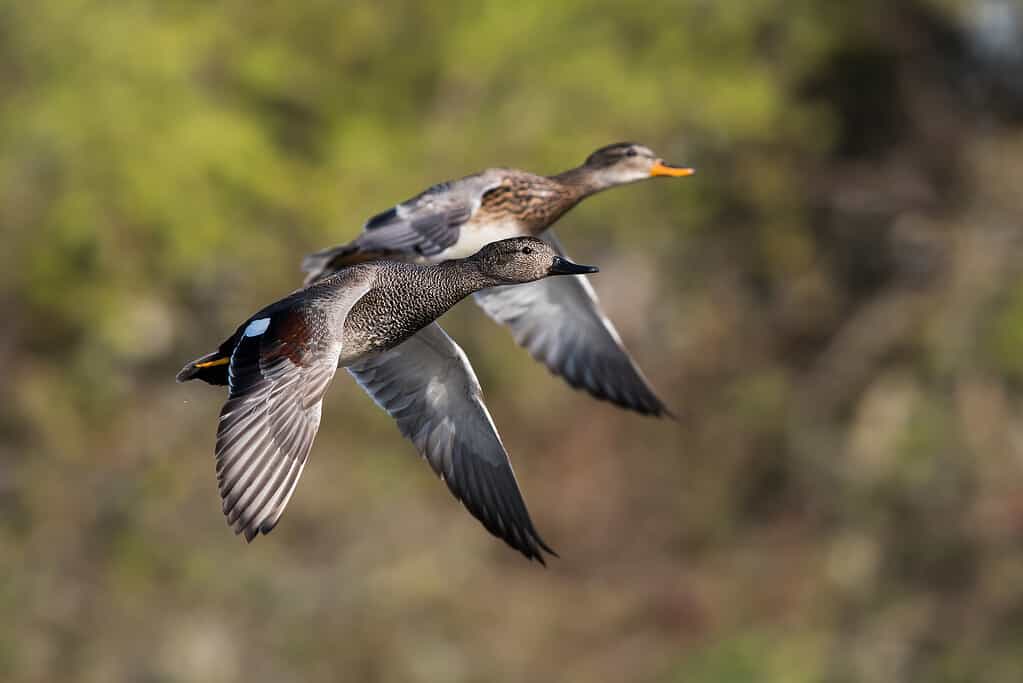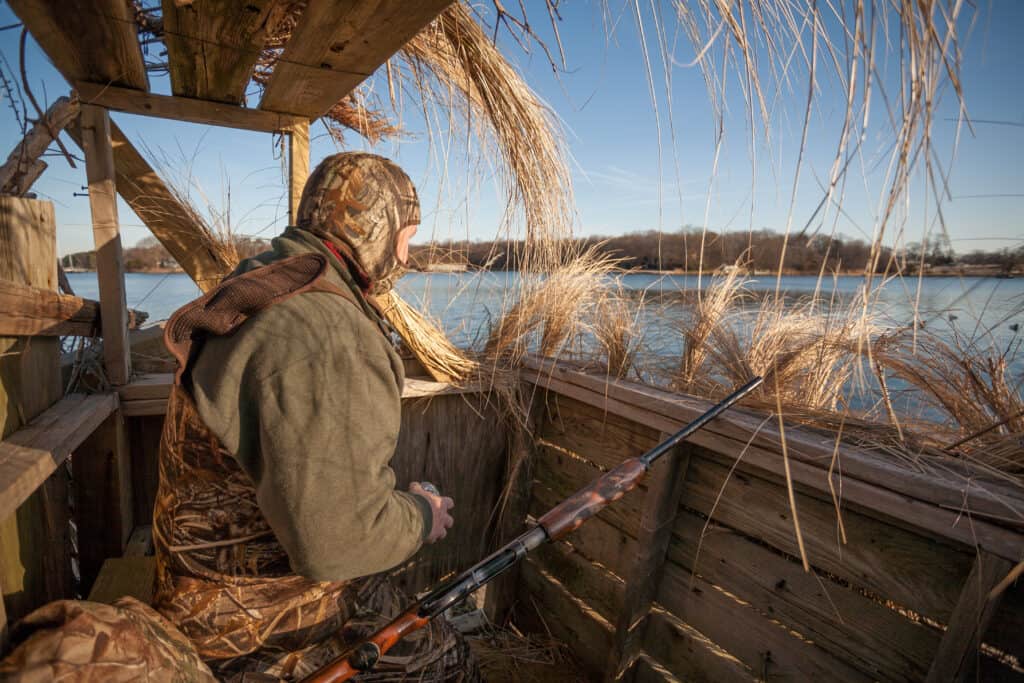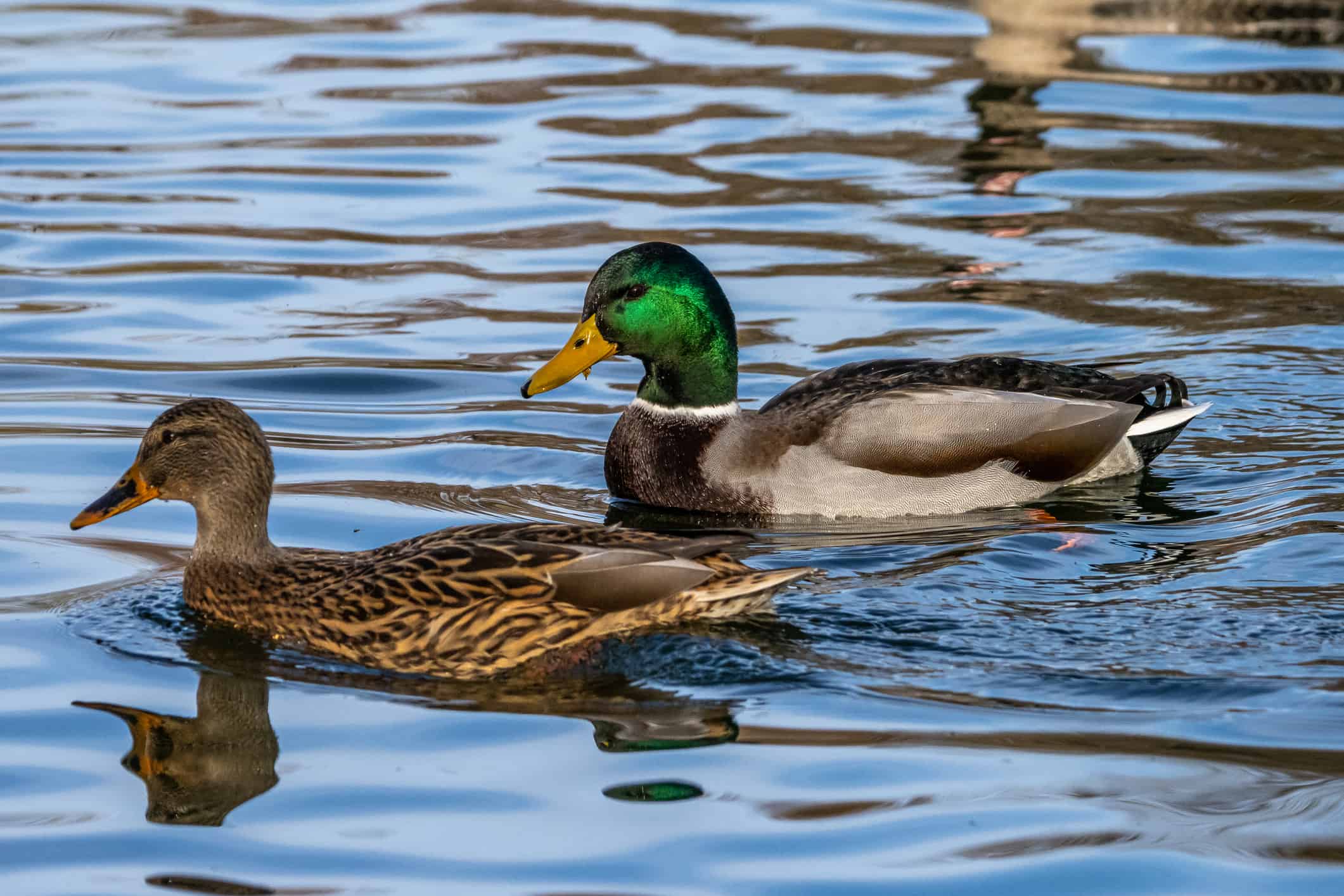Before you know it, it’ll be duck hunting season in Vermont. Are you prepared? If not, then we’re here to help. Today, we’ll be filling you in with all the information you need for the upcoming season, including the dates, the best places to hunt, where you can hunt, what you’ll want to take along the way, and more.
Can You Duck Hunt in Vermont?
The first thing you’ll need to know about duck hunting season in Vermont is if it’s legal to hunt there in the first place. The answer is yes, you can duck hunt in Vermont.
When Does Duck Hunting Season in Vermont Start?

Check the dates below to see when you can hunt the various ducks in Vermont.
©Maciej Olszewski/Shutterstock.com
We know you’re excited to get started, but wait until the official season begins. Duck hunting season in Vermont officially starts on October 14th, and the season length is 60 days.
Duck Hunting Season Dates in Vermont
The length of the season and details about the dates will depend on where in the state you’re planning to hunt. So, look at the details of your area, and if you plan to hunt in the Interior, Lake Champlain Zone, Connecticut River Zone, etc.
The hunting season can also vary depending on the type of birds you plan to hunt. This chart will give you a general idea:
| Bird | Season Dates |
|---|---|
| Ducks | Split Season – Oct. 14 – Oct. 18 & Oct. 28 – Dec. 21 |
| Scaup | Split Season – Oct. 14 – Oct. 18 & Oct. 28 – Dec. 21 |
| Mergansers | Split Season – Oct. 14 – Oct. 18 & Oct. 28 – Dec. 21 |
| Coots | Split Season – Oct. 14 – Oct. 18 & Oct. 28 – Dec. 21 |
| Canadian Geese | Split Season – Sept. 1 – Sept. 25, Oct. 14 – Nov. 27, Dec. 1 – Jan. 6 |
| Snow Geese | Split Season – Oct. 1 – Dec.31, 2023, Feb. 24 – Mar. 10, 2024, Mar. 11 – Apr. 26, 2024 |
| Brant | Straight Season – Oct. 14 – Nov. 12, 2023 |
Daily Bag Limits
The state of Vermont is pretty liberal when it comes to bag limits and how many fowl you can get in a 24-hour period. The different areas of Vermont are all the same as far as bag limits, but they will differ based on the type of bird. Follow this chart:
| Bird | Daily Bag Limit |
|---|---|
| Ducks | 6 During the dates of Oct. 14 – Oct. 18 6 18 & Oct. 28 – Dec. 21 |
| Scaup | 25 During the dates of Oct. 1 – Dec. 31, 2023, & Feb. 24 – Mar. 10, 2024 15 During the dates of Mar. 11 – Apr. 26, 2024 |
| Mergansers | 6 During the dates of Oct. 14 – Oct. 18 6 18 & Oct. 28 – Dec. 21 |
| Coots | 15 During the dates of Oct. 14 – Oct. 18 6 18 & Oct. 28 – Dec. 21 |
| Canadian Geese | 8 During the dates of Sept. 1 – Sept. 25 3 During the dates of Oct. 14 – Nov. 27 5 During the dates of Dec. 1 – Jan. 6 |
| Snow Geese | 25 During the dates of Oct. 1 – Dec. 31, 2023, & Feb. 24 – Mar. 10, 2024 15 During the dates of Mar. 11 – Apr. 26, 2024 |
| Brant | 1 During the dates of Oct. 14 – Nov. 12 |
Possession Limits
Like the bag limits, the total possession limits will also be the same as far as a location but different based on the type of bird being hunted. Follow this chart:
| Bird | Possession Limit |
|---|---|
| Ducks | 18 During the dates of Oct. 14 – Oct. 18 6 18 & Oct. 28 – Dec. 21 |
| Scaup | 6 During the dates of Oct.14–Oct. 18/Oct. 28–Nov. 11 3 During the dates of Nov. 12 – Dec. 21 |
| Mergansers | 18 During the dates of Oct. 14 – Oct. 18 6 18 & Oct. 28 – Dec. 21 |
| Coots | 45 During the dates of Oct. 14 – Oct. 18 6 18 & Oct. 28 – Dec. 21 |
| Canadian Geese | 24 During the dates of Sept. 1 – Sept. 25 9 During the dates of Oct. 14 – Nov. 27 15 During the dates of Dec. 1 – Jan. 6 |
| Snow Geese | No Possession Limit |
| Brant | 3 During the dates of Oct. 14 – Nov. 12 |
Where Can You Hunt in Vermont?
The state of Vermont is split into three primary waterfowl hunting zones. You can choose any of them for your hunting needs. They include:
The Connecticut River Zone – This includes portions of Vermont and New Hampshire and also the Connecticut River.
The Lake Champlain Zone – The area includes the Champlain Valley lowlands that are in New York and Vermont. Plus, Lake Champlain itself.
The Interior Vermont Zone – This is basically the rest of Vermont.
The Types of Ducks in Vermont
The amazing thing about duck hunting season in Vermont is that there’s a huge variety of different ducks to hunt in the area. There are many ducks in the area, which is why the possession limits are so liberal.
Dabbling Ducks
This category of duck is typically found in freshwater. They’re called dabblers because, when they feed, they tip their heads down and their butts go up.
- Mallard Ducks – Known for their distinctive iridescent green heads, brown breasts, pale bodies, and white necks. Mallards love to swim, so you’ll find them in the water during the hunt.
- American Black Duck – This type is similar to Mallards, but they’re smaller, and they’re typically brown in color with gray beaks. They’re basically hybrids. You’ll find them in the water or on land.
- Wood Duck – The wood duck has a unique look and they can come in a variety of colors. The male has a green appearance similar to Mallards, and the females are brown. They are usually found solo or in pairs but not in a flock.
- American Wigeon – You’ll find the American Wigeons in the water like the Mallards, but they’re also ground nesters. The males are white and green, while the females are primarily brown.
- Eurasian Wigeon – It can be hard to identify the Eurasian Wigeon because the female looks like the American Wigeon, and the male has a light brown stripe going down from its head. However, the Eurasian does have a warmer brown color on their heads.
- Gadwall Duck – The Gadwall is stocky and gray-brown. The male has black feathers on its backside, and the females have brown feathers in that area.
- Northern Pintail – This is a slender duck often identified by its long tail. The male has a black bill, and the female has a gray bill.
- Northern Shoveler – The Shoveler is also extremely identifiable due to its long spoon-shaped beak. The males have the iridescent green head and the females are speckled brown. This duck has the longest bill of dabbling ducks.
- Blue-Winged Teal – This duck is identifiable by its distinctive dark blue face, dark bill, crescent face, and white patch of white feathers. You can identify this duck while in the air by its sky-pale blue feathers.
- Green-Winged Teal – This is the smallest type of dabbling duck and it has a short neck and a short bill. This is one of the most common ducks in the state. Although they’re common, they’re fast flyers, so be ready.
Diving Ducks
Another of the ducks that you’re likely to see during duck hunting season in Vermont are the diving ducks, which are found in fresh and salt water. Look for them in lakes, streams, inlets, and bays. They tend to dive pretty deep into the water, so they may give you an extra challenge. Here are some that you may encounter:
- Ruddy Duck – This species is identifiable by its cocked-up tail and large head. Males have a black cap on their heads while the females look similar but have a brown cap. You’ll often see them sleeping with their heads tucked in during the day.
- Ring-Neck Duck – Found year-round in Vermont, this duck has a brown ring around its neck. However, the rest of the duck is also brown, so it can be hard to see. Find it in woody-edged marshes.
- Lesser Scaup – You’ll find this bright-eyed duck on freshwater ponds and lakes. The female has a white crescent around their bill, and the males have a black head. Both can be identified by their square-top heads.
- Greater Scaup – You may be able to see these ducks in large numbers on saltwater lakes and bays. The male has a black head, and the family has that white crescents like the Lesser Scaup. The real difference between the two is that the Greater Scaup has more of a rounded head.
- Canvasback – This is a large duck that you can identify by its sloping head that’s different from other diving ducks. The male has a chestnut-red head, and the female heads are light brown. The Canvasback also makes a unique hooting sound during mating season.
- Redhead Duck – You’ll be lucky if you see this Redhead because it’s quite rare in Vermont. However, it’s quite striking with its vibrant red color. The females have a bluish-gray bill, which is also quite striking.
- Common Goldeneye – Visit during duck hunting season in Vermont, and you’re likely to see the Goldeneye, which has very vibrant golden eyes. They also have a white wing patch that’s very noticeable when they fly.
- Barrow’s Goldeneye – This duck’s claim to fame is the golden eye and the black and white “windowpane” designs that grace its shoulders. You can find this duck in salt and freshwater.
- Hooded Merganser – Noticeable by their long and slender bills, this hooded variant is easy to spot. The males have a cinnamon body while the females have a long gray body.
- Common Merganser – The traditional merganser has a slender orange bill. The males have white bodies, and the females are gray with cinnamon-colored heads.
- Red-Breasted Merganser – You have a chance to spot this bird during migration, and when you do, you’ll see their slim serrated bills. The male’s bill is red. The female is orange. To survive, this duck needs to eat an average of 17 fish a day, so you’ll see them diving a lot.
Sea Ducks
These are also a type of diving duck, but they can stay underwater for the longest amount of time, so be patient. Most of them live on offshore islands during the summer and the coastal waters in the winter. Keep an eye out for these while duck hunting season in Vermont.
- Long-Tailed Duck – This variant has a more compact body but a very long tail that you can’t miss. They’re mostly brown or black with white markings. They are fast flyers, so be ready.
- Harlequin Duck – Another compact bird, this duck also has a very small bill. The males are very recognizable, with blue bodies that have white spots and white stripes. The females are mostly brown with white spots.
- Black Scoter – You’ll only find the Black Scoter during the winter months. The males are black and have orange bills, while the females are darker and have white patches around their cheeks.
- White-Winged Scooter – As the name suggests, this duck will have some white near the tip of their wings. The males also have a black top, and the females have a darker top, but they have white patches near their cheeks.
- Surf Scooter – The Scooter is easy to identify. The males are mostly black, but they have a white patch on the forehead. The females have two patches on their faces. You can typically find this duck where the breaking waves are near the shore.
What to Bring for Best Chances for Success During Duck Hunting Season in Vermont

A well-built blind will give you a good chance of capturing your desired duck.
©Brian N Rogers/Shutterstock.com
There are a few items that you’ll want to prepare before you jump into duck hunting season in Vermont or anywhere else. The first thing you’ll need is your identification. All hunters over 16 years old will require a current Federal Migratory Bird Hunting and Conservation stamp. You can get these through the post office.
The other items that can help a lot include:
- Shotgun
- Blind bag
- Dog Whistle
- Decoys
- Shotgun sling
- Gloves
- Warm clothing
Essential Duck Hunting Tips to Remember
Before you head out, there are a number of duck-hunting tips that you absolutely must practice when you’re out in the field. Consider these tips during your next duck hunting expedition:
Don’t Give Up Too Early
Many hunters decide to call it quits early into the morning if they don’t have a lot of luck right away. However, many migrating flocks stop to take a rest later in the morning. Wait until then and you could have luck.
Clean Your Duck Caller
Over time, a lot of food and crime can get into your plastic and acrylic birt caller and the sound can get muffled. Take the time to clean it out so you get the most realistic sound possible. The best cleaning solution is a combination of mild soap and water.
Know the Direction of the Wind
It’s essential to know the direction of the wind so you can properly position your blinds and decoys. To check the wind direction, put some talcum powder in a squeeze bottle and let it go to see what direction the wind travels.
Conclusion
This concludes all you need to know for duck hunting season in Vermont in 2023. Mark the dates on your calendar, research the types of ducks and fowl you’d like to capitalize on and pack the essential items to help you along the way. Best of luck, and stay safe.
Thank you for reading! Have some feedback for us? Contact the AZ Animals editorial team.








